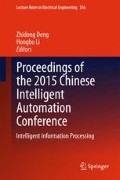Abstract
Multiview object classification and recognition is of great importance in many applications such as computer vision and robotics by Kuo and Nevatia (Applications of computer vision (WACV), p. 18, 2009). This paper focuses on the specific case of multiview pedestrian image classification. The contributions of this paper are twofold. First, we collected a new multiview pedestrian dataset, which has been manually labeled with viewpoint, posture, and scene category tags. Second, a nonnegative least square (NNLS)-based multiview pedestrian image classification method is presented by Pang et al. (IEEE transactions on image processing, vol 20, pp. 1388–1400). Experimental results demonstrate that the proposed method is robust and effective.
Access this chapter
Tax calculation will be finalised at checkout
Purchases are for personal use only
References
Zheng J, Jiang LV, Phillips PJ, Chellappa R (2012) Crossview action recognition via a transferable dictionary pair. In: BMVC 2012, p 111
Kuo CH, Nevatia R (2009) Robust multiview car detection using unsupervised subcategorization. In: Applications of computer vision (WACV), p 18
Pang J, Huang Q, Yan S, Jiang S, Qin L (2011) Transferring boosted detectors towards viewpoint and scene adaptiveness. In: IEEE transactions on image processing, vol 20, pp. 1388–1400
Kan M, Shan S, Zhang H (2012) Multiview discriminant analysis. In: ECCV 2012, Part I, LNCS, vol 7572, pp 808–821
Zhang H, Nasrabadi NM, Huang TS, Zhang Y (2011) Multiview face recognition via joint dynamic sparse representation. In: International conference on image processing, pp 3025–3028
Timofte R, Zimmermann K, Gool LV (2009) Multiview traffic sign detection, recognition, and 3D localisation. In: Applications of computer vision (WACV), p 18
Ye Q, Han Z, Jiao J, Liu J (2013) Human detection in images via piecewise linear support vector machines. IEEE Trans Image Process 22:778789
Viola P, Jones M, Snow D (2005) Detecting pedestrians using patterns of motion and appearence. Int J Comput Vis 63:153161
Dalal N, Triggs B (2005) Histograms of oriented gradients for human detection. In: IEEE CVPR, pp 886–893
Sun H, Wang C, Wang BL, Elsheimy N (2011) Pyramid binary pattern features for realtime pedestrian detection from infrared video. Neurocomputing 74:707804
Enzweiler M, Gavrila DM (2011) Multilevel mixture of experts framework for pedestrian classification. IEEE Trans Image Process 20:2967–2979
Felzenszwalb PF, Girshick RB, McAllester D, Ramanan D (2010) Object detection with discriminatively trained part based models. IEEE Trans Pattern Anal Mach Intell 32(9):1627–1645
Zhang L, Yang M, Feng X (2011) Sparse representation or collaborative representation: which helps face recognition? In: Proceedings of the 2011 international conference on computer vision, pp 471–478
Heiler M, Schnorr C (2005) Learning nonnegative sparse image codes by convex programming. In: Proceedings of the 2005 international conference on computer vision, pp 1667–1674
Li Y, Ngom A (2013) Nonnegative least squares methods for the classification of high dimensional biological data. In: IEEE/ACM transactions on computational biology and bioinformatics, vol 10, pp 447–456
Acknowledgments
The authors would like to thank Mr. Guanliang Zhang for collecting and organizing the multiview pedestrian dataset. This work was supported in part by the National Natural Science Foundation of China under Grant 61303186, 61240058, and by the Ph.D. Programs Foundation of Ministry of Education of China under Grant 20124307120013.
Author information
Authors and Affiliations
Corresponding author
Editor information
Editors and Affiliations
Rights and permissions
Copyright information
© 2015 Springer-Verlag Berlin Heidelberg
About this paper
Cite this paper
Wu, L., Sun, H., Ji, K., Fan, Y., Zhang, Y. (2015). Multiview Image Classification via Nonnegative Least Squares. In: Deng, Z., Li, H. (eds) Proceedings of the 2015 Chinese Intelligent Automation Conference. Lecture Notes in Electrical Engineering, vol 336. Springer, Berlin, Heidelberg. https://doi.org/10.1007/978-3-662-46469-4_21
Download citation
DOI: https://doi.org/10.1007/978-3-662-46469-4_21
Published:
Publisher Name: Springer, Berlin, Heidelberg
Print ISBN: 978-3-662-46468-7
Online ISBN: 978-3-662-46469-4
eBook Packages: EngineeringEngineering (R0)

